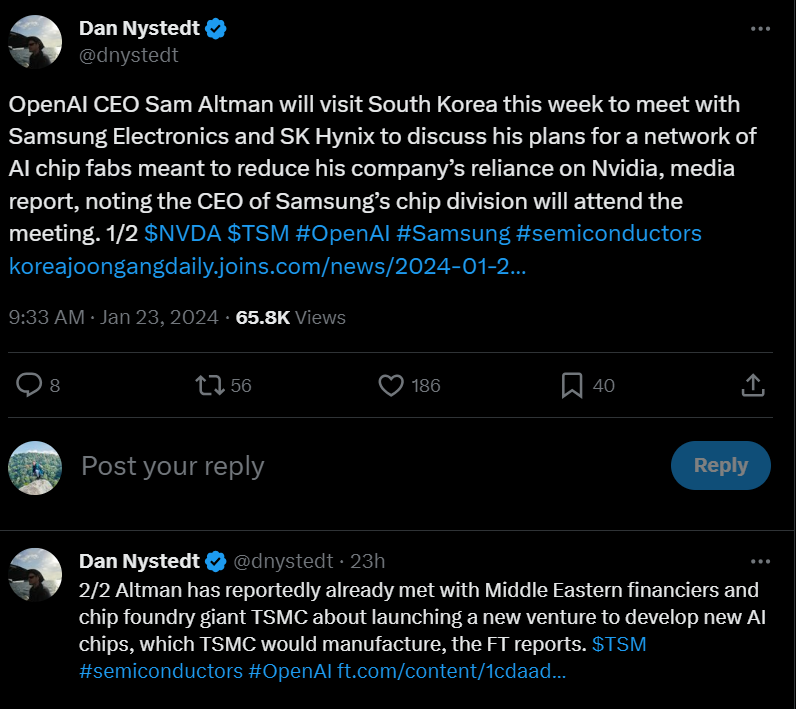OpenAI’s in-house chip odyssey: Sam Altman aims for a network of fabs

- Sam Altman, CEO of OpenAI, has been wooing investors like G42 and SoftBank, for chip fabs capital.
- His urgency stems from the expected chip supply shortage by the decade’s end.
- Insiders have revealed that the planned network aims to partner with top-tier chip manufacturers and will have a worldwide reach.
In a thought-provoking revelation during The Wall Street Journal’s Tech Live event on October 2023, Sam Altman said he would “never rule out” that OpenAI could end up crafting its own AI chips. While acknowledging that OpenAI is not currently developing proprietary chips, Altman hinted that realizing the grand vision of attaining general AI might necessitate the company venturing into chip creation. Many saw it as a dynamic stance, underlining OpenAI’s adaptability and commitment to pushing boundaries in the ever-evolving landscape of AI. Additionally, if OpenAI were to, for instance own the patent on the chips that made general AI possible, it would essentially own the future of the world.
READ NEXT

New horizons with OpenAI GPT updates
However, Altman has long emphasized the importance of developing specialized hardware to meet the unique demands of AI. Project Tigris emerges from this vision: to craft a dedicated chip tailored to optimize the processing requirements of OpenAI’s advanced AI models.
What is the significance of in-house chips for OpenAI?
Developing an in-house chip promises to significantly improve the performance and efficiency of OpenAI’s AI models. By customizing hardware to align with the specific needs of advanced machine learning algorithms, OpenAI aims to push the boundaries of what AI can achieve, potentially unlocking new possibilities in fields ranging from natural language processing to computer vision.
At the heart of Altman’s intention is to keep OpenAI from being thrown off course by the seemingly simple obstacle of microchip shortages. The scarcity of these vital components, crucial for the advancement of AI, has already become a colossal headache for Altman and numerous tech executives striving to replicate OpenAI’s triumphs.
Project Tigris emerges from this vision to craft a dedicated chip tailored to optimize the processing requirements of OpenAI’s advanced AI models. Altman has repeatedly emphasized that the existing chip supply needs to meet OpenAI’s insatiable requirements.
But Altman’s endeavors faced a temporary hiatus when he was briefly removed as OpenAI CEO in November, 2023. However, soon after his return, the project was reignited. Altman has even explored the possibility with Microsoft, and sources reveal the software giant’s keen interest in the venture.
What has Sam Altman planned for OpenAI now?
The latest development is that Altman has discreetly initiated conversations with potential investors, aiming to secure substantial funds not just for AI chips but for creating whole chip-fabrication plants, affectionately known as fabs. Veiled in anonymity, sources disclosed that among the companies engaged in these discussions was G42 from Abu Dhabi – a revelation by Bloomberg last month – and the influential SoftBank Group.
“The startup has discussed raising between US$8 billion and US$10 billion from G42,” said one of Bloomberg‘s anonymous sources on the story. “It’s unclear whether the chip venture and wider company funding efforts are related,” the report reads. Unbeknown to many, this fab project entails collaboration with top chip manufacturers to use the expertise of established industry players, ensuring that Project Tigris benefits from the latest advancements in semiconductor technology.
While Bloomberg previously hinted at fundraising efforts for the chip venture, the accurate scale and manufacturing focus have yet to be unveiled. Still in their early stages, these talks have not yet finalized the list of participating partners and backers, adding a layer of intrige to this evolving narrative.
Is OpenAI’s venture into building its chip fabs a viable endeavor?

Altman courting Korean expertise and money? Source: X.com.
Ultimately, Altman advocates for urgent industry action to ensure an ample chip supply by the end of the decade. However, his approach, emphasizing the construction and maintenance of fabs, diverges from the cost-effective strategy favored by many AI industry peers, including Amazon, Google, and Microsoft—OpenAI’s primary investor.
These tech giants typically design custom silicon and outsource manufacturing to external suppliers. The construction of a cutting-edge fab involves a significant financial investment, often reaching tens of billions of dollars, and establishing a network of such facilities spans several years. A single chip factory’s cost can range from US$10 billion to US$20 billion, influenced by factors such as location and planned capacity.
For instance, Intel’s Arizona fabs are estimated at US$15 billion each, and TSMC’s nearby factory project is projected to reach around US$40 billion. Moreover, these facilities may require four to five years for completion, with potential delays due to current workforce shortages. Some argue that OpenAI seems more inclined to support leading-edge chip manufacturers like TSMC, Samsung Electronics, and potentially Intel rather than enter the foundry industry.
In an article in The Register, it’s suggested that the strategy could involve channeling raised funds into these fabrication giants, such as TSMC, where Nvidia, AMD, and Intel’s GPUs and AI accelerators are manufactured. TSMC stands out as a prime candidate, given its role in producing components for significant players in the AI industry.
“If he gets it done—by raising money from the Middle East or SoftBank or whoever—that will represent a tech project that may be more ambitious (or foolhardy) than OpenAI itself,” Cory Weinberg said in his briefing for The Information.
While the ambition behind Project Tigris is commendable, inherent challenges and risks are associated with developing custom hardware. The intricacies of semiconductor design, production scalability, and compatibility with existing infrastructure pose formidable hurdles that OpenAI will need to overcome to realize the full potential of its in-house chip.









